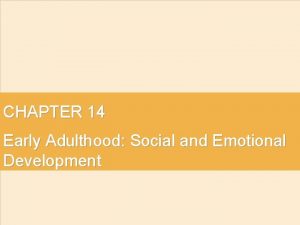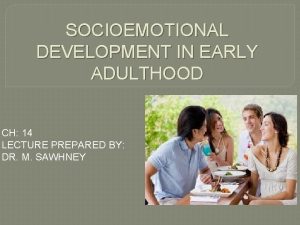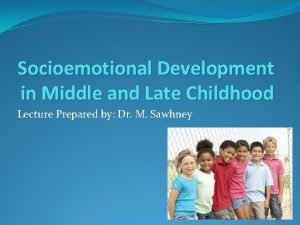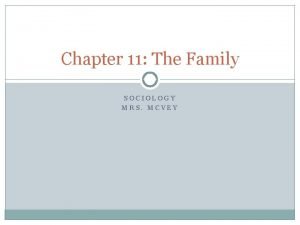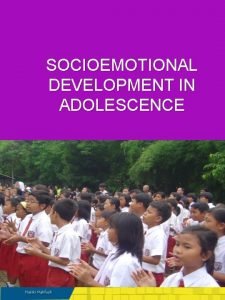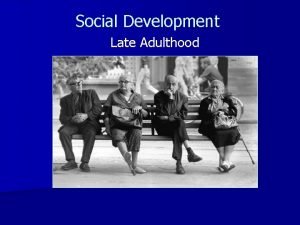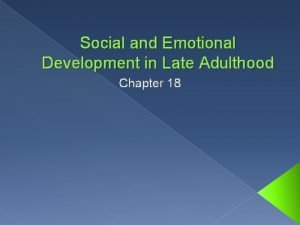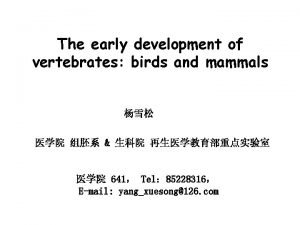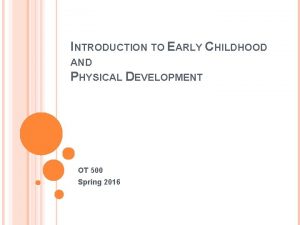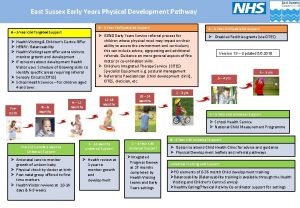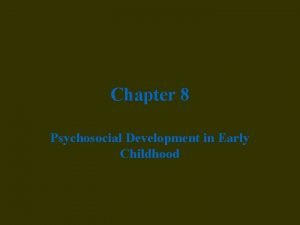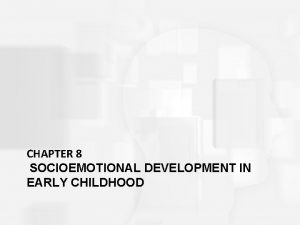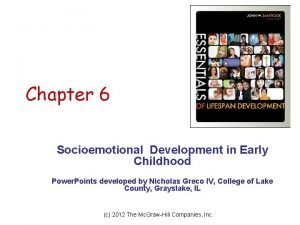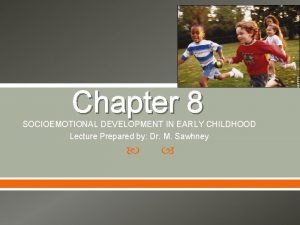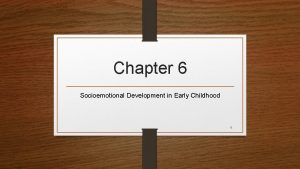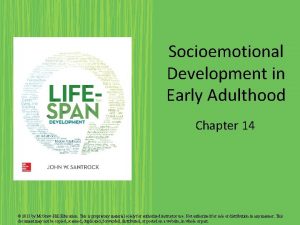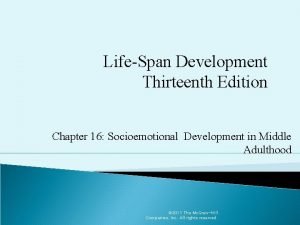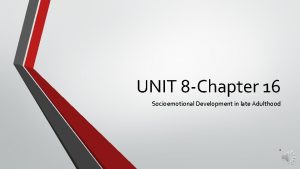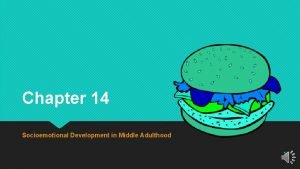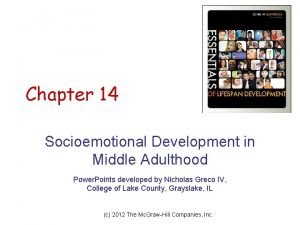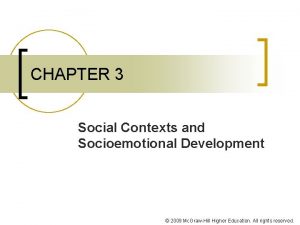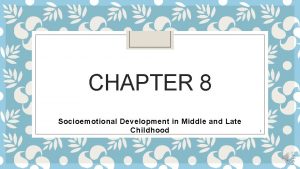Unit 6 Chapter 12 Socioemotional Development in Early




















- Slides: 20

Unit 6: Chapter 12 Socioemotional Development in Early Adulthood 1

Learning Goals Describe stability and change in socioemotional development from childhood to adulthood. Identify some key aspects of love and close relationships. Characterize adult lifestyles. Discuss the challenges in marriage, parenting, and divorce. Summarize the roles of gender and communication in relationships. 2

Stability and Change For adults, socioemotional development revolves around adaptively integrating our emotional experiences into enjoyable relationships with others on a daily basis v Attachment plays an important part in socioemotional development v Secure attachment to parents during childhood correlates with more satisfaction with adult relationships v If researchers measure an individual’s self-concept at ages 10, 20, 30, and 40 years, they are likely to find the most self-concept stability between ages of 20 and 30. v Early adulthood is linked with childhood in that prior life experiences influence what we are like in adulthood 3

Adult Attachment Category Secure attachment style v Adults have positive views of relationships v Research studies linking early infant attachments with parents and later attachments in adult romantic relationships have suggested that securely attached infants usually become securely attached adults in romantic relationships, but this association may be lessened by stressful and disruptive experiences in childhood v Results from a recent study linking adults’ current attachment styles with other aspects of their lives have shown that adults with insecure attachment styles tend to be more likely to be depressed than securely attached adults. Avoidant attachment style v Adults are hesitant to get involved in romantic relationships v Results from a recent study linking adults’ current attachment styles with other aspects of their lives have shown that adults with insecure attachment styles tend to be more likely to be depressed than securely attached adults. Anxious attachment style v Adults demand closeness, are less trusting, and more emotional, jealous, and possessive 4

Love and Close Relationships Intimacy is the aspect of love becomes increasingly important to the young adult Erikson’s psychosocial crisis for the person in early adulthood intimacy versus isolation According to Erikson, if individuals do not develop intimacy, they face isolation Erikson, achievement of intimacy requires that an individual has achieved identity According to Erikson, achieving intimacy means to be able to find oneself while losing oneself in another. Intimacy and independence Relationships in early adulthood strive to balance independence, identity, and intimacy Relationships with spouses and lovers tend to differ from relationships with friends in the areas of sexuality and infatuation 5

Erikson Stage six: Intimacy vs. Isolation Psychosocial Crisis: Intimacy vs. Isolation (18 -30 years) Significant relationships: Partner/friendship Psychosocial modalities: To loose and find oneself in another Psychosocial virtues: Love Maladaptive: Promiscuity Malignancy: Exclusion 6

Romantic and Affectionate Love Affectionate love or companionate love A type of love that is characterized by an individual’s desire to have the other person near and to share a deep, caring relationship with the other person. This type of love includes intimacy and commitment, but does not include sexual attraction. Romantic Love A type of love that has strong sexual and infatuation components and often predominates in the early period of a romantic relationship. How might these types of love influence expectations about love and marriage? 7

Sternberg’s Theory of love THE FOUR TYPES OF LOVE PROPOSED BY ROBERT J. STERNBERG TYPE OF LOVE 1. Infatuation Is marked by high passion, but low or absent intimacy and commitment. 2. Affectionate love Is marked by low passion, but high intimacy and commitment 3. Fatuous love Is marked by low intimacy, but high passion and commitment 4. Consummate love Is marked by high passion, intimacy, and commitment 8

Adult Lifestyles Single adult 75% single Adults, in 2006 advantage of autonomous decision-making disadvantage of lack of intimacy common problem of being single; finding a niche in a marriage-oriented society Women in 30 s-more pressure from society to get married 9

Adult Lifestyles (con. ) Cohabiting Adults Ø Refers to the couples who live together in a sexual relation without being married. Ø Sweden-cohabitation virtually universal before marriage Ø Research suggests that cohabiting before marriage increases the likelihood of divorce. Ø Research indicates that cohabiting adults live together tend to be a short-lived (less than a year) Ø Dealing with the disapproval from family members about living together without being married. 10

Married Adults Marital trends Since the early 1900 s, the goal of maintaining a stable marriage has decreased in its level of relative importance The major change in the last 60 years that has increased the fragility of marriages is the desire for personal fulfillment both inside and outside of marriage In the U. S. an average for a first marriage as of 2007 was around 27 men, 26 women Benefits of good Married Men and women report how happy they are in their marriage, the trend is that husbands tend to be happier One of the benefits of marriage is to increase longevity Individuals who are happily married live longer, healthier lives than either divorced individuals or those who are unhappily married People in unhappy marriages may experience numerous physical ailments, such as high blood pressure and heart disease, as well as psychological problems such as anxiety, depression, and substance abuse 11

Divorce Adults Increases in divorce are correlated with youthful marriage, low educational level, low income, not having a religious affiliation, divorced parents, having a baby before marriage Between 1980 and 2007 the divorce rate in the United States increase significantly Divorce average of 5 -10 years These characteristics also increase the likelihood of divorce: Alcoholism, psychological problems, domestic violence, infidelity, and inadequate division of household labor 12

Remarried Adults Divorced adults remarry within 3 years after divorcing. With regard to the timing of remarriage, in the United States, men tend to remarry sooner than women do. Whereas first-married couples have the greatest chance of divorcing after 5 -10 years of marriage, remarried couples are more likely to divorce in the first several years of marriage. 13

Gay and Lesbian Adults gay and lesbian couples they have a large number of sexual partners. they do not have long-term relationships. one partner assumes a masculine role, and one partner assumes a feminine role 14

Making Marriage Work Love Maps Nurturing Fondness and admiration Turing toward each other instead of turn away Letting your partner influence you Creating Shared Meaning 15

Becoming A Parent Adults’ expectations about their roles as parents vary widely from couple to couple By giving birth to fewer children, women free up time for other endeavors Working women invest less actual time in the child’s development Men are apt to invest a greater amount of time in fathering Parental care is often supplemented by institutional care There advantages and disadvantages to having children early and later in life secure income for child-rearing expenses than a younger mother would have. fewer medical problems with pregnancy and childbirth 16

Strategies for Divorced Adults Hetherington recommends these: Think of divorce as a chance to grow personally and to develop more positive relationships Make decisions carefully Focus more on the future than the past Use your strengths and resources to cope with difficulties Don’t expect to be successful and happy in everything you do 17

Gender and Communication Tannen distinguishes two ways of communications: Rapport talk -- language of conversation; a way of establishing connections and negotiating relationships Report talk -- talk that is designed to give information; includes public speaking Women enjoy rapport talk more than report talk; men’s lack of interest in rapport talk bothers many women Men prefer to engage in report talk 18

Who is the lucky one? Udry’s filter theory of mate selection Propinquity: All possible dating partners are first screened by geographical location. Attractiveness: This “accessible” individual attribute can be observed early in the process and is used to screen out undesirable individuals. Cross-culturally, males value physical attractiveness more than females, whereas females value economic earning power more. Social Background: Similarity is the key in this filter. People tend to marry individuals who are similar in religion, political affiliation, education, occupation, and social class. Education and occupation have become more important, while religion has become less important in mate selection. Consensus: This filter involves similarity in specific attitudes and values, thus it goes a step further than the broad social background filter. Complementarity: Does this individual complement me or complete me? Individuals seek partners that fit well with them. Readiness for Marriage: Are both partners ready to get married or commit to a marriage-like relationship? Discrepancies in this filter can terminate a relationship despite the success of the previous filters. Udry, J. R. (1971). The social context of marriage (2 nd ed. ). New York: Lippincott 19

See you next two week 20
 Social development in early adulthood
Social development in early adulthood Socioemotional development in early adulthood
Socioemotional development in early adulthood Socioemotional development in infancy
Socioemotional development in infancy Socioemotional development in late adulthood
Socioemotional development in late adulthood Late childhood social development
Late childhood social development What is social development in middle adulthood
What is social development in middle adulthood Socioemotional maintenance definition
Socioemotional maintenance definition It is a self portrait composed of many pieces
It is a self portrait composed of many pieces Late adulthood social development
Late adulthood social development Peck's theory of ego integrity
Peck's theory of ego integrity Early childhood is ____ for language learning
Early childhood is ____ for language learning Early cpr and early defibrillation can: *
Early cpr and early defibrillation can: * Unit 10, unit 10 review tests, unit 10 general test
Unit 10, unit 10 review tests, unit 10 general test Early development in birds
Early development in birds Early adulthood cognitive development
Early adulthood cognitive development Fine motor skills development in early childhood
Fine motor skills development in early childhood Quiz 1: development of industrial revolution
Quiz 1: development of industrial revolution Physical development in early childhood
Physical development in early childhood Developmental milestones 40-65 years
Developmental milestones 40-65 years Psychosocial development in early childhood
Psychosocial development in early childhood Physical development during early adulthood
Physical development during early adulthood
